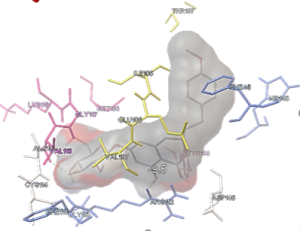
Agrimonolide-6-O-Glucopyranoside: A Promising Agent for Drug Development and Antimicrobial Ointments Derived from Henna from the land of Fujairah, UAE
Henna, scientifically known as Lawsonia inermis, has long been revered for its multifaceted uses, spanning from cultural rituals to medicinal applications. This plant, belonging to the Lythraceae family, can grow between two to six meters tall and features elliptical leaves with a broad, lance-like shape. Its adaptability to harsh soil conditions, including extreme alkalinity and acidity, makes it a resilient species. Originating from arid regions, henna has found a significant place in the traditions of various cultures, including those in the United Arab Emirates (UAE).
The study conducted at the Fujairah Research Centre, explores the nutritional and mineral composition of henna, along with its antimicrobial properties. Fresh leaves of Lawsonia inermis were collected from two different regions in Fujairah, specifically Dedna and Dibba, and were subjected to various analyses.
The nutritional analysis of henna leaves revealed the presence of essential minerals like potassium, magnesium, and calcium, which are crucial for numerous bodily functions. The samples were processed using international standard methods, including those outlined by the Association of Official Analytical Chemists (AOAC). This rigorous analysis confirmed that henna is a valuable source of these minerals, contributing to its potential health benefits.
In addition to its nutritional value, henna exhibits significant antimicrobial properties. The antimicrobial assessment, performed using the disc diffusion method, demonstrated potent antibacterial activity against Bacillus cereus and Staphylococcus aureus. The inhibition zones for these bacteria were 30-32 mm and 15-20 mm, respectively. Furthermore, henna showed antifungal activity against Aspergillus flavus and Candida albicans, with inhibition zones of 9-10 mm and 11-12 mm, respectively. These results underscore henna's potential as a natural antimicrobial agent.
A crucial part of the study involved docking analysis to understand the interactions between henna's phytochemicals and microbial proteins. This analysis highlighted the high binding energy interactions of Agrimonolide-6-O-glucopyranoside with the AcuA protein's binding pocket and surrounding residues. Agrimonolide-6-O-glucopyranoside emerged as a promising compound for drug development, supported by theoretical ADMET (Absorption, Distribution, Metabolism, Excretion, and Toxicity) analysis and drug-likeness evaluation. These findings suggest that henna, particularly its phytochemical Agrimonolide-6-O-glucopyranoside, could serve as a natural alternative to conventional antimicrobial agents.
The historical and contemporary uses of henna extend beyond its antimicrobial properties. Traditionally, henna has been used for its anti-inflammatory, antioxidant, hepatoprotective, anticancer, and anti-inflammatory effects. These medicinal properties are attributed to the presence of bioactive compounds such as fraxetin, dihydrodehydrodiconiferyl alcohol, lawsoniaside, 2-methoxy-3-methyl-1-butene, coumarin, and gallic acid. The study highlights the need for further research to explore the full therapeutic potential of these compounds.
The research conducted provides a comprehensive understanding of henna's potential as a therapeutic agent. The findings suggest that henna leaves, with their rich array of phytochemicals, could be developed into various antimicrobial products, including topical creams, ointments, and disinfectants. This aligns with the growing interest in natural and alternative antimicrobial strategies, especially in the face of increasing antibiotic resistance. The in-silico analysis component of the study further strengthens the case for henna's therapeutic potential. By evaluating the phytochemicals' ability to prevent the spread of infectious diseases, the study opens up new avenues for the development of natural antimicrobial agents. The docking simulations showed that the phytochemicals from henna have a strong affinity for microbial proteins, indicating their potential effectiveness in inhibiting microbial growth.
Moreover, the theoretical pharmacokinetics and toxicological profiling conducted using PreADMET 2.0 provided valuable insights into the safety and efficacy of these phytochemicals. This web-based application predicted various ADME properties, toxicity endpoints, and drug-likeness factors, confirming that compounds like Agrimonolide-6-O-glucopyranoside have promising profiles for drug development.
In conclusion, the comprehensive analysis of henna from Fujairah, UAE, underscores its nutritional, antimicrobial, and therapeutic potential. The findings from this study provide a strong foundation for further research into henna's phytochemicals and their applications in medicine. By exploring the nutritional composition, mineral content, and antimicrobial activity, this research enhances our understanding of henna's benefits and supports its traditional uses in various cultures. The promising results from docking analysis and theoretical evaluations suggest that henna could be a valuable natural resource in the development of new antimicrobial agents, offering an alternative to conventional treatments and addressing the challenges posed by antibiotic resistance.
Reference:
Amal Salem Khamis Hamad ALSAMAHI, Hajer Ali Abdulla ALHMOUDI, Shaher Bano MIRZA, and Fouad Lamghari RIDOUANE. (2023). Comprehensive analysis of nutritional composition, mineral content, antimicrobial activity, and theoretical evaluation of phytochemicals in henna (Lawsonia inermis) from Fujairah, United Arab Emirates. Int. J. Biol. Chem. Sci. 17(7): 2614-2630. DOI: https://dx.doi.org/10.4314/ijbcs.v17i7.2
